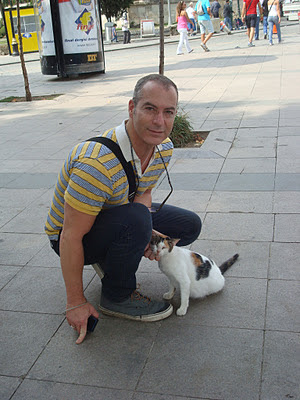
My Stray Cat Expedition in Istanbul, Turkey – Part 2
We left the hotel early, since we had a big day ahead. A quick review of geography may be in order here, before we proceed.
Istanbul is a huge city, with almost 15 million people. The city spreads over a very large area, on both banks of the Bosphorus strait. The Bosphorus runs north and south, dividing the city in half, with the eastern half located in Asia, and the western half located in Europe. A small inlet of the Bosphorus, called the Golden Horn, runs roughly east to west, slicing through the middle of European Istanbul. The area north of the Golden Horn is the modern, European-feeling, very westernized New District. This is where our hotel was located. South of the Golden Horn is the Old Town – the 3,000 year old historical core of the city. Near the tip of the Old Town peninsula is a district called Sultanahmet, where many of the city’s most famous sights can be found, and this was where we were headed this morning.
We quickly located the metro station and easily figured out how to buy tokens and use Istanbul mass transit. We took the funicular from Taksim to Kabatas, and then the tram from Kabatas to the Sultanahmet station. After grabbing an authentic breakfast – pastries and Turkish tea, and then headed through Sultanahmet Park, spotting many kitties along the way, like this cute little gray and white kitten.
Our destination: the Hagia Sophia, arguably the greatest house of worship in the Christian and Muslim worlds. Pronounced “aya so-fee-ya”, this Great Church of Constantinople was built by the Byzantine Emperor Justinian in 537 A.D. It started as a church, then became a mosque, and is now Istanbul’s most impressive museum. The Hagia Sophia opened at 9:00. I arrived 20 minutes early, and could see a crowd gathering already. Most of the visitors were clustered around the entrance, or wooden benches nearby. I was debating whether to stand on the ticket line, or just hang out on one of the benches, when I spotted a very cute cat sitting comfortably amongst the tourists on one of the benches.
Of course, this influenced my decision.
I chose to sit on the bench, rather than stand in the boring old line.
To my delight, the cat made himself at home on my lap.
As 9:00 approached, I removed the kitty from my lap and purchased my ticket.
There really are few words to describe how overwhelming, majestic and awe-inspiring Hagia Sophia is.
The space is immense. You could fit the entire Notre Dame cathedral within the space beneath the great dome. The main dome is 185 feet high and 105 feet in diameter. It’s breathtaking.
Originally, Hagia Sophia was a church, the apse faced Jerusalem. When Hagia Sophia was converted into a mosque, a small off-center niche was added in the apse’s circular wall. This niche shows the precise direction to face during prayers, as Muslims must face Mecca during prayer. Next to the apse is the mimber (pronounced meem-behr), a pulpit used by the imam to deliver his Friday sermon. The imam stands halfway up the stairs, as a sign of respect; the uppermost step is reserved for the prophet Muhammad.
The mimber was certainly impressive. What I found equally compelling was the little cat curled up sleeping near the mimber’s bottom step.
After the Hagia Sophia, we strolled through Sultanahmet Park to the next spectacular building, the famous Blue Mosque. This mosque is one of the finest in the world. Built in just seven years (1609 – 1616), the scale is impressive and the rich blue handmade ceramic tiles that dominate the interior are amazing. The other notable feature, beside the opulent interior and the impressive scale, is the six minarets. The minaret is the tower where the call to prayer is announced, five times a day. A single minaret was adequate for most mosques, given its straightforward function. Mosques financed by sultans often wanted to impress people, by having more minarets. This was my first entry into a mosque, and I had to obey protocol. Men and women are required to have their knees and shoulders covered. I knew this in advance, so I made certain not to wear shorts on days that I’d be visiting mosques. Shoes must be removed before entering a mosque. At the Blue Mosque (and at most others), plastic bags are dispensed for shoes to be stored and carried. Because everyone had their shoes off, the first thing I noticed when I entered the Blue Mosque was the smell of feet. The place could definitely have used a few blasts of Febreeze. The next thing you notice, once your eyes adjust to the dim lighting, is the intensely decorated interior. More than 20,000 ceramic tiles were used to decorate the mosque. This was the pinnacle of Ottoman architecture.
The dome was modeled after the one used in Hagia Sophia.
As I exited the Blue Mosque through the courtyard, I noticed a man sitting in the corner with a sketchpad, drawing the mosque. A black and white cat was sleeping very nicely on the artist’s bag.
This cat got a little restless and began wandering the courtyard. Naturally, I called it over. And being The Cat Whisperer, she obediently followed.
After spending the morning at two major sites, it was time for lunch. Not far from the Blue Mosque was Sultanahmet Koftecisi, a restaurant famous for their kofte, or meatballs.
On my way there, I spotted a calico cat across the street. She was a sweet and friendly cat, and she was noticeably pregnant. I befriended her right away.
While eating my lunch (meatballs, of course; overrated, by the way), I stashed a few sizable hunks of meat in a napkin and carried it back across the street, hoping to find the mother-to-be. Fortunately, she hadn’t wandered far, and she happily accepted my offer. She didn’t think they were overrated at all.
With my batteries recharged after lunch, we headed to the Turkish and Islamic Arts Museum. The museum has a thoughtful collection of artifacts spanning the course of Turkish and Islamic civilizations. Frankly, the museum wasn’t all it was cracked up to be, however, the carpet collection was impressive. Only a handful of 13th century Selcuk carpets exist today, and more than half of the world’s collection is in this room. They were gathered from mosques and shrines in central Turkey.
While leaving the museum, I noticed a cute little mackerel tabby walking alongside me. He was a very socialized cat, and immediately came over to me when I bent down. He also let me pick him up with no resistance.
The next stop on the tour of the Old Town was the Underground Cistern. This vast underground reservoir dates back to the Byzantine Emperor Justinian’s reign in the sixth century A.D. I had read that this was a pretty funky, cool site to visit. Finding the exact location was a bit tricky, but that was okay, because the walk through the streets of the Old Town was an adventure in itself. In fact, while strolling through the back streets of Istanbul, I saw one of the many notable acts of kindness to cats that would characterize my trip. Apparently, a cat has run inside a restaurant and was trying to mooch food from either the owner or the patrons. The proprietor of the restaurant was in the process of tossing the cat out of the restaurant. In most instances like this, I would expect the owner to shoo the cat out with a broom, or by stamping his feet, or applying whatever negative stimulus necessary to get the cat to leave the restaurant running. Instead, I watched as the restaurant worker gently carried the young cat (to the smiles of the customers, I might add) out to the sidewalk, and neatly placed her on the ground. She was a young cat and was really adorable. I couldn’t resist, of course, and I went over to say hi.
We had a little trouble finding the cistern on our own. Ultimately, I had to point to the cistern in my guidebook and ask a local to point me in the direction. As I approached, I had to walk through a nice square, with a lot of outdoor cafés. Running around on the grass nearby were a group of orange and white kitties. They looked like siblings, and they were very playful, chasing each other and rolling in the grass. One of them ran up a nearby shrub and enthusiastically sharpened her claws on the branches, while another tagged along.
We finally found the Underground Cistern, purchased our tickets, and descended the stairs into the cistern. The site before us was pretty amazing. This massive reservoir – the largest in Constantinople at the time it was built – was created to meet the needs of the fast-growing, bustling Byzantine city, and to provide precious water in case of a shortage. The cistern inside was about the size of two football fields. A forest of 336 columns provides structure for the ceiling overhead. Most were recycled from earlier Roman ruins, and this can be seen in the variety of capitals (tops of columns) in the cistern. Each column was lit from below by an orange light, giving the place a warm eerie glow.
At the far end of the cistern was an interesting sight. There are two Medusa heads lying on the ground, one sideways and one upside down, squeezed beneath two smaller pillars. The Greeks often carved this mythological creature, with the hair made of snakes and the gaze that could turn people into stone, into tombstones or cemetery walls to scare off grave robbers. In Roman times, she became a protector of temples. Whether these Medusas were here to scare people or to offer protection, or whether the architect simply needed the proper base to raise the two small columns to ceiling height remains unknown. Regardless, it was the most popular part of the cistern.
Because I’m an anal retentive nutjob, I had the day’s itinerary laid out (week’s) ahead of time, and I didn’t have to spend much time getting oriented. This allowed us to finish today’s sites with time to spare. So, we decided to walk the back streets of the old town, for a less touristy experience. We walked uphill from the Sultanahmet tram stop to an old cemetery, filled with graves of the bigwigs. For some reason, I enjoy strolling through cemeteries when I’m on vacation. I visited a great cemetery (The Recoleta Cemetery) in Buenos Aires, and another great one in Cuba, and of course, the fabulous Pere La Chaise cemetery in Paris (where you can find, amongst many others, the graves of Edith Piaf, Oscar Wilde, and Jim Morrison). They’re usually peaceful and quiet and nicely landscaped. And, I’ve noticed, most of the cemeteries have a friendly resident feline population living in them. In this cemetery in Istanbul, I was not disappointed.
The walk continued, and we wove our way down the bustling street named Divan Yolu. This street has been the city’s transportation thoroughfare since Byzantine times. Now, it’s lined with shops and restaurants. We passed a famous statue, Cemberlitas (also known as the Burned Column), the beautiful Nuruosmaniye Mosque (which was closed for renovations), and the insanely busy Grand Bazaar, a roofed warren of 4000 shops and stores. Once we passed the bazaar, we were no longer in the Sultanahmet district. We were now in the Beyazit district, where Istanbul University’s main campus is located. In Beyazit, the market crowds and the student population come together, giving the area a special flavor. I looked at my guidebook. I could see that I was coming across Uzun Carsi Caddesi, a busy street with shops that cater to locals. Lots of hardware stores, stationery shops, toy stores, shoe stores, etc. This was the real Istanbul, the city that I was hoping to see, rather than the sanitized, tourist-only version.
This street led downhill, dead-ending at the Rustem Pasa Mosque. This mosque was built by the famous architect Sinan in the 16th century. The mosque’s façade was covered in beautiful 16th century Isnik tiles. The interior was even more stunning.
After leaving the mosque, we continued down another street, Hasircilar Caddesi, also known as “mat-weaver’s alley), and ended up at the Egyptian Spice Market. We decided to skip going inside the market, since this was part of tomorrow’s itinerary. Instead, we strolled the stalls on the outside of the market, which was actually a more authentic experience. Just past the Spice Market, we emerged upon Eminonu Square. This square is dominated by the New Mosque of the Mother Sultan (or simply, the “New Mosque”).
While standing in the square, we saw a vendor from one of the fish stalls bordering the Spice Market come out and dump a bucket of fish guts on the ground nearby. Immediately, a flock of seagulls (the birds, not the 80’s band) descended on them, like sharks in a feeding frenzy.
A nearby cat watched the scene with jealousy. I thought she was eyeing the birds, but the birds were huge, and I doubt she wanted to tangle with them.
Finally, the seagulls left, and although she was left with slim pickings, she wasn’t complaining.
Eminonu Square was a nice place to spend the rest of the afternoon. The square was once a huge outdoor bazaar. There are lots of people milling about, and it’s a great place for people watching. And pigeon watching. The square is loaded with them. There are even vendors selling bird seed, allowing a tourist to be swarmed by pigeons for that great photo opportunity. I confess to doing this in St. Mark’s Square, in Venice. Today, I had no interest in being pelted with pigeon poop. I passed. I decided not to go into the New Mosque, but I did go into the lovely courtyard. There I encountered a nice kitty curled up asleep on top of a trash can.
With twilight approaching, it was time to head back to the hotel. After a brief rest and a shower, it was back on the street: Istiklal Street, where all of Istanbul tends to descend for eating, drinking, shopping, socializing, and partying, every night of the week. We didn’t make it a late night, as we have another busy agenda tomorrow. So, after a huge buffet dinner again, it was back to the hotel. To avoid waking up at 2:30 a.m. again, I popped one of Satan’s aspirin (i.e. Ambien) in my mouth and called it a night.
CONTINUE TO The Istanbul, Turkey Stray Cat Adventure – PART 3



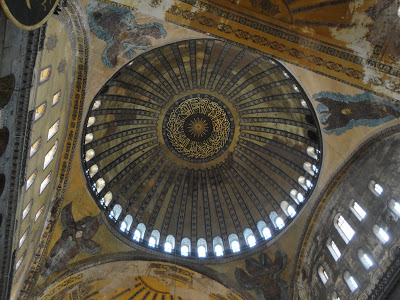
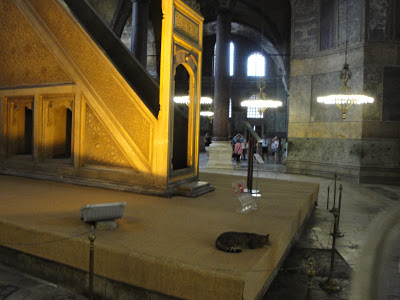
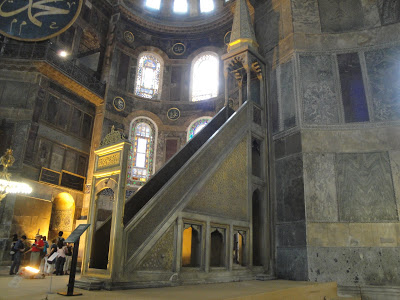
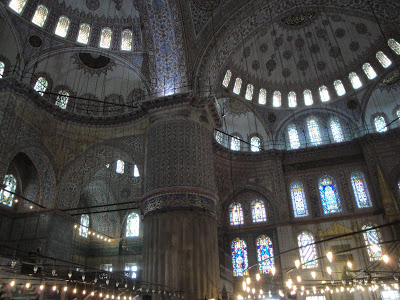
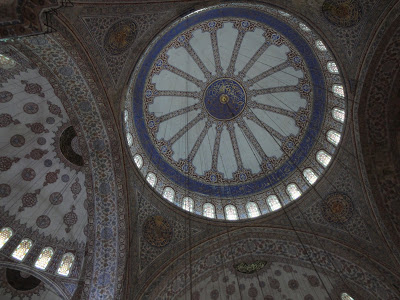
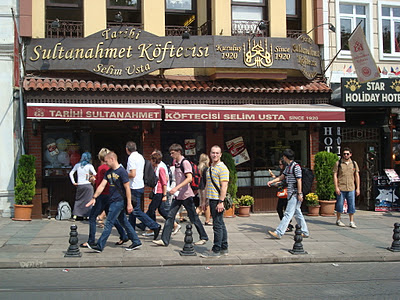
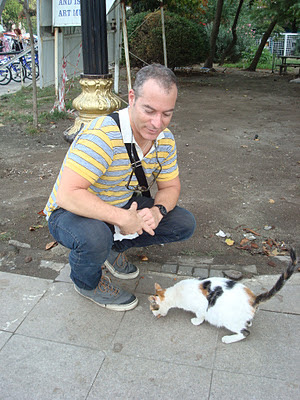
1 Comment
Carina
I was just in Istanbul a couple months ago. Loved the city, but it broke my heart to see so many street cats. My goal at every restaurant was to get seated at a table near the sidewalk, the better I could sneak scraps to street cats. I even took meats from breakfast at our hotel to pass out to cats I'd pass. I just kept telling myself that restaurant workers and shopkeepers (and tourists like me) must feed them. The bartender at our hotel told me that there's a city service that periodically collects the cats to give them basic vet care, sterilization, and then releases them. I wonder if you know anything about this. Do you think there is anything us cat lovers can do to help the Turkish street cats–or maybe they don't need help? Hope you have a great trip Cheers, The owner of two of your patients